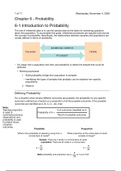Class notes
Class notes Chapter 6 STATS-2126 Essentials of Statistics for the Behavioral Sciences, ISBN: 9780357035580
- Course
- PSYC-2606 (STATS2126)
- Institution
- Laurentian University (LU )
Lecture notes study book Essentials of Statistics for the Behavioral Sciences of Frederick J Gravetter, Larry B. Wallnau, Lori-Ann B. Forzano, James E. Witnauer (Chapter 6) - ISBN: 9780357035580 (chapter 6)
[Show more]



